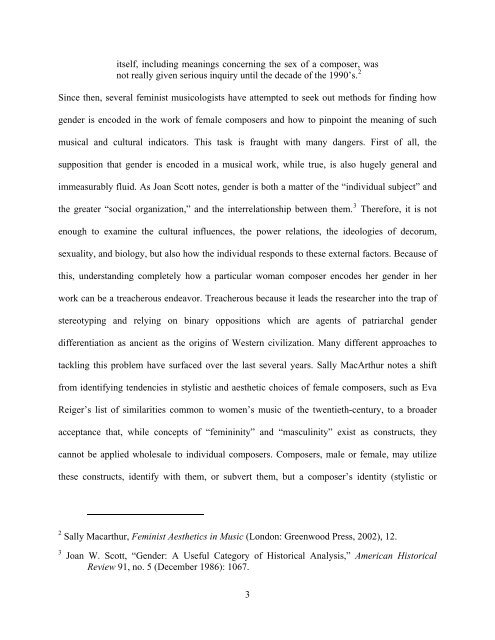Download - D-Scholarship@Pitt - University of Pittsburgh
Download - D-Scholarship@Pitt - University of Pittsburgh
Download - D-Scholarship@Pitt - University of Pittsburgh
Create successful ePaper yourself
Turn your PDF publications into a flip-book with our unique Google optimized e-Paper software.
itself, including meanings concerning the sex <strong>of</strong> a composer, was<br />
not really given serious inquiry until the decade <strong>of</strong> the 1990’s. 2<br />
Since then, several feminist musicologists have attempted to seek out methods for finding how<br />
gender is encoded in the work <strong>of</strong> female composers and how to pinpoint the meaning <strong>of</strong> such<br />
musical and cultural indicators. This task is fraught with many dangers. First <strong>of</strong> all, the<br />
supposition that gender is encoded in a musical work, while true, is also hugely general and<br />
immeasurably fluid. As Joan Scott notes, gender is both a matter <strong>of</strong> the “individual subject” and<br />
the greater “social organization,” and the interrelationship between them. 3 Therefore, it is not<br />
enough to examine the cultural influences, the power relations, the ideologies <strong>of</strong> decorum,<br />
sexuality, and biology, but also how the individual responds to these external factors. Because <strong>of</strong><br />
this, understanding completely how a particular woman composer encodes her gender in her<br />
work can be a treacherous endeavor. Treacherous because it leads the researcher into the trap <strong>of</strong><br />
stereotyping and relying on binary oppositions which are agents <strong>of</strong> patriarchal gender<br />
differentiation as ancient as the origins <strong>of</strong> Western civilization. Many different approaches to<br />
tackling this problem have surfaced over the last several years. Sally MacArthur notes a shift<br />
from identifying tendencies in stylistic and aesthetic choices <strong>of</strong> female composers, such as Eva<br />
Reiger’s list <strong>of</strong> similarities common to women’s music <strong>of</strong> the twentieth-century, to a broader<br />
acceptance that, while concepts <strong>of</strong> “femininity” and “masculinity” exist as constructs, they<br />
cannot be applied wholesale to individual composers. Composers, male or female, may utilize<br />
these constructs, identify with them, or subvert them, but a composer’s identity (stylistic or<br />
2 Sally Macarthur, Feminist Aesthetics in Music (London: Greenwood Press, 2002), 12.<br />
3 Joan W. Scott, “Gender: A Useful Category <strong>of</strong> Historical Analysis,” American Historical<br />
Review 91, no. 5 (December 1986): 1067.<br />
3















